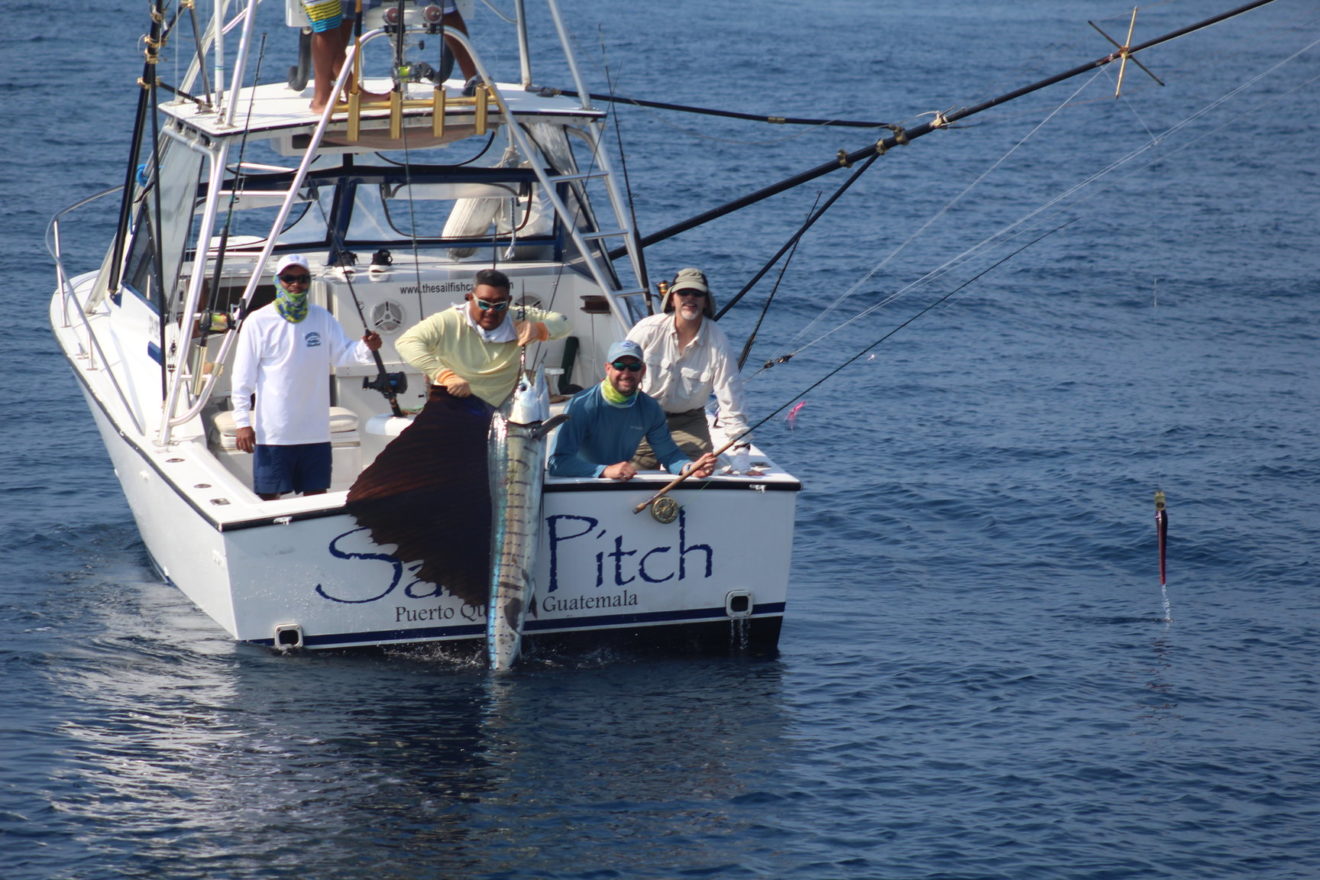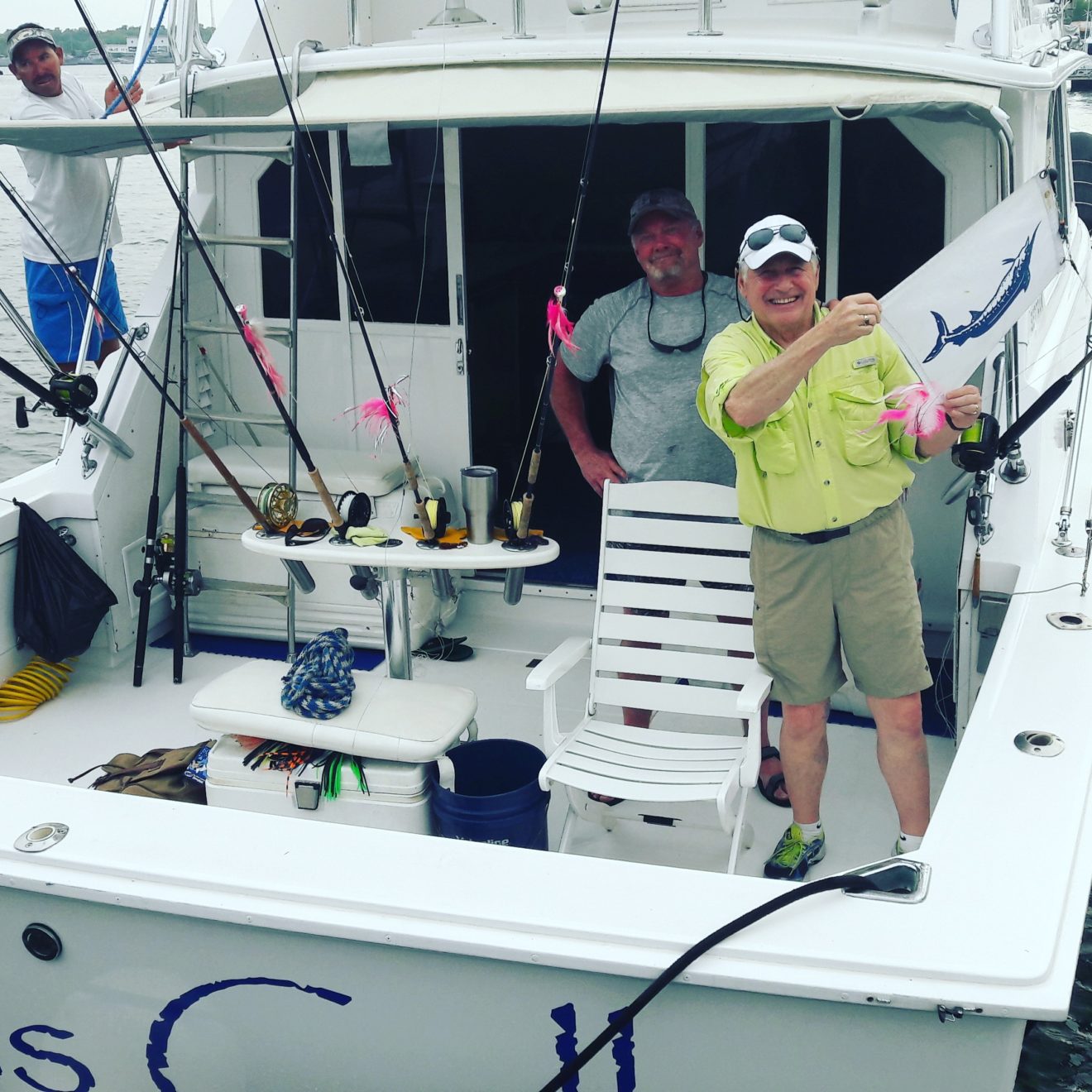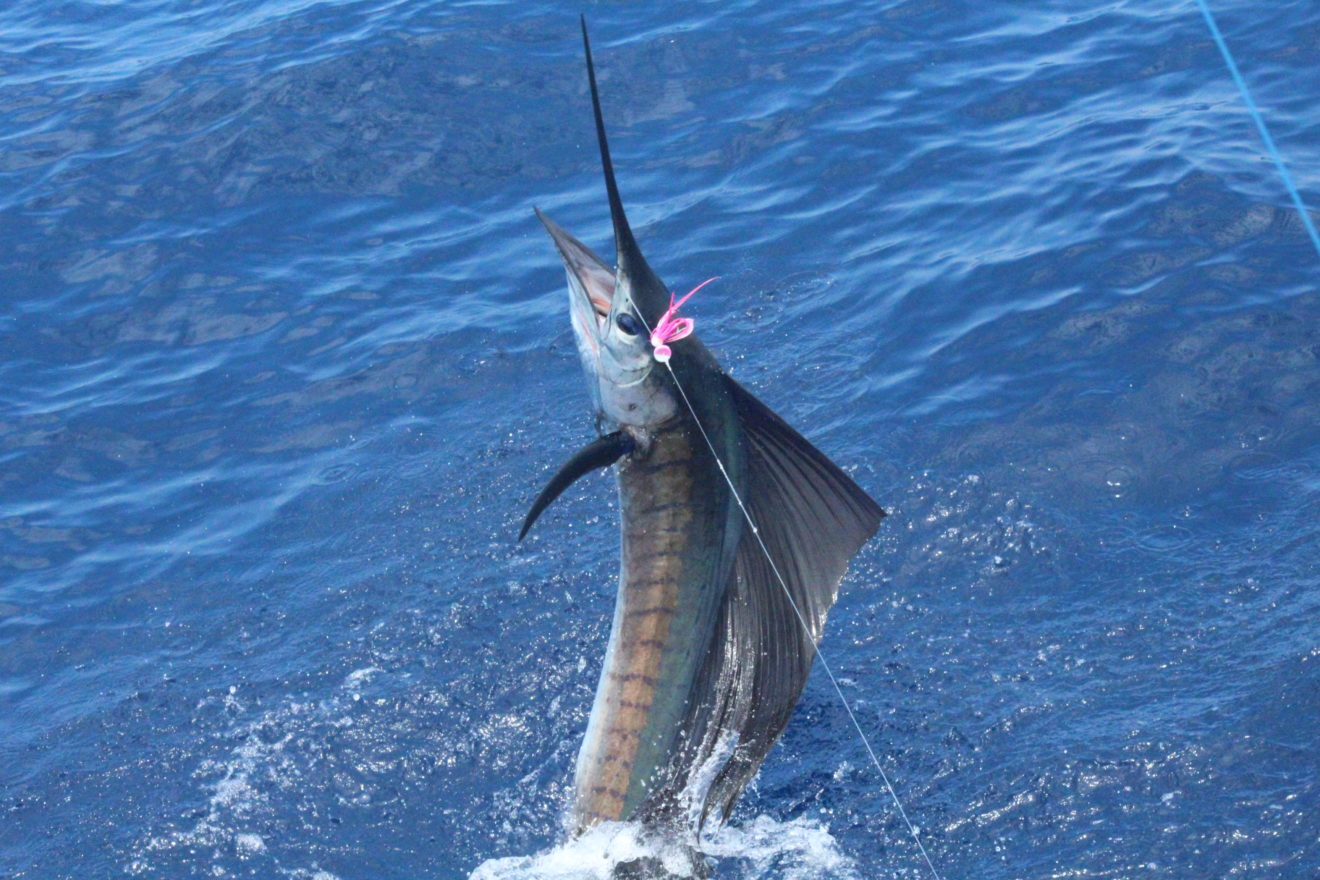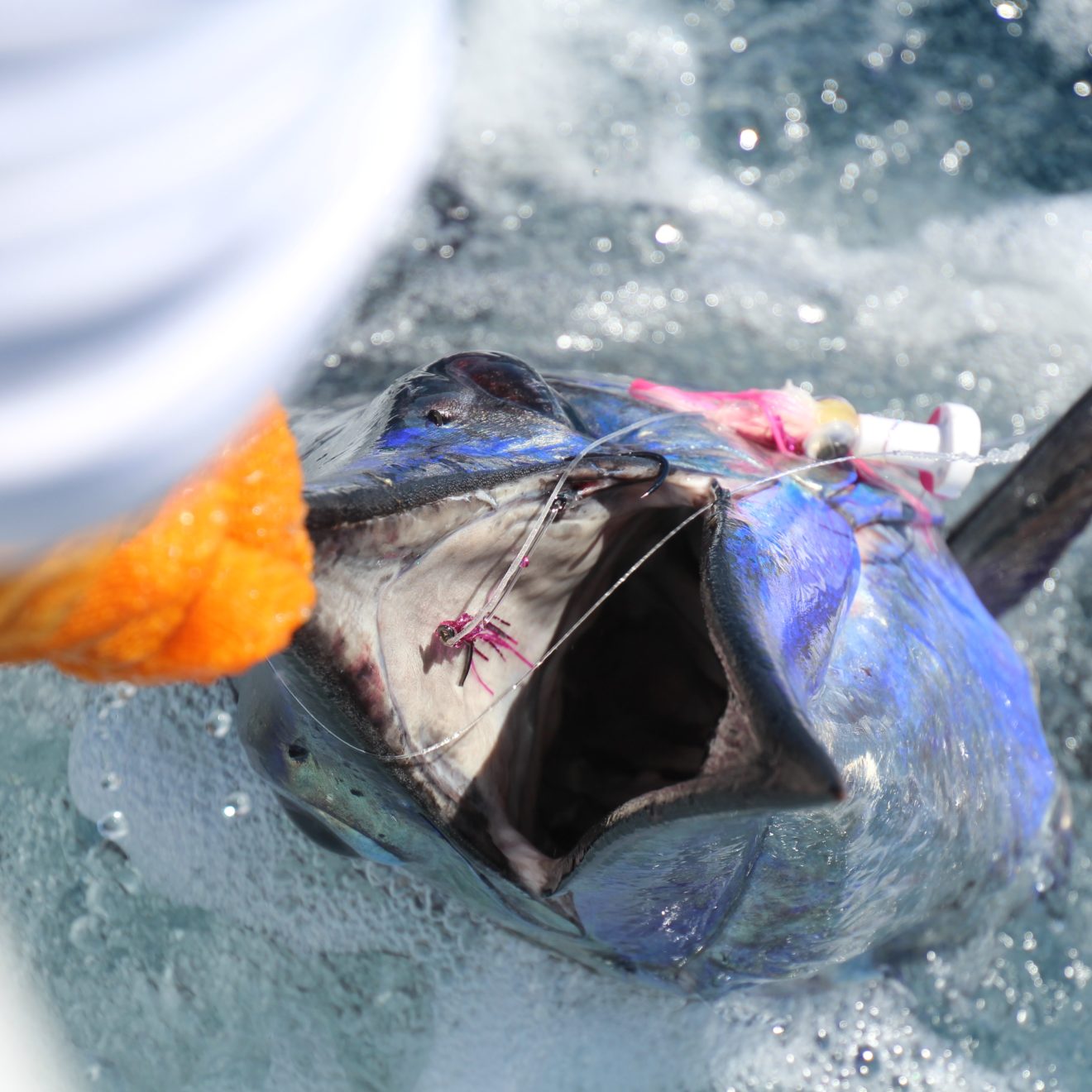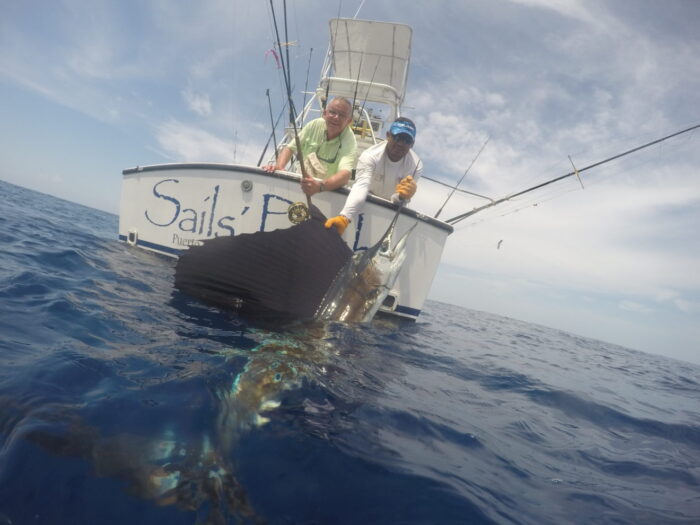Fly Fishing for Billfish! You should try it!
When you think of fly fishing as a non-fly angler, the idea of middle-aged men in river waders wearing reading glasses while rocking the newest Orvis get-up comes to mind, as a scene from “A River Runs Through It.” The truth is, it’s far from that.
I grew up fishing steal head, brook trout, brown trout, and salmon in Northern Michigan. At 14 years old, I first picked up a fly rod to catch brook trout with my Grandpa. It wasn’t until later in life I was catching billfish for a living.
I have never had anyone come to Guatemala on a 3-day trip and NOT catch a billfish on the fly in 12 years. It’s the most exciting thing in this sport of fishing: the surface bite! We all chase this feeling like a bunch junkies. This is when fly fishing turns into an adrenaline-filled sport. You are genuinely under matched, and that makes the victory that much sweeter.
Using traditional bait-and-switch tactics, like a circle hook rigged to dead bait, we can also achieve this same idea for fly fishing. The approach we use brings the action very close to the surface. It’s visional with greater hookup ratios and, of course, highly addictive!
Bait-and-switch has allowed us to take advantage of these top-tier predators in such a way that we can position them within 5-10 yards of the transom. It’s all downhill when they get hot, and from the moment they show up, it’s a matter of only a few seconds and here comes the BITE! Rinse and repeat.
THE SPREAD
In Guatemala, most Skippers will run similar spreads. Each boat has its sweet spot, but this is the idea.
If you are running a bait spread, it’s like this: 2 ballyhoo rigger baits long on the outriggers swimming with a 7/0 to 8/0 circle hooks (chin weights rigged on the ballyhoo ¾ oz). We keep those rods in the rocket launcher in the center of the cockpit. That way you can do a lot of damage without moving. We will also swim two flat baits off the transom, but I like mine long (maybe 25 yards back).
Then there are the teasers. Off the riggers, we have two teaser rods (one on each side), known as the “long teaser.” These teasers are on a type of release clip called a roller troller, which means they can pop free like any outrigger clip, and a special teaser rod and reel is controlling these teasers. It’s a short, stiff rod and fast, heavy reel.
The mates work these rods. The idea is to keep the teasers just ahead of the fish. Those very flat baits I mention will be just ahead of those long teasers. If something shows up, you simply pop the flat clip loose from the transom and you are there on that long teaser in a matter of a flick of the wrist.
Finally, the short teasers. These teasers are fixed to the outrigger through a series of pulleys, and the man in charge of these is the Captain on the bridge. In total, it’s 4 baits and 4 teasers in the water. Nothing crazy, lots of clean water lanes, and plenty of space between teaser and bait.
We keep two more pitch baits out of the water in case something shows up on the short teasers. A bigger pitch bait (tuna or mackerel) is for the marlin. It’s always easier and faster to drop the bait back then it is to reel up.
A general rule is, never reel a bait up to cover a position inside. It never fails as you are abandoning your spot to cover another spot, a fish is about to eat your bait, and you just removed yours to cover one in front! In Guatemala, it’s VERY common to have quads to the whole family (6 Sails) working everything you got back there, and you will even need more baits to be deployed to get them all!
Fly Fishing Spread
Now let’s talk fly fishing. As before, the front of the boat is the same. The right outrigger (port side) will be closed to avoid objects getting in the way of the backcast. Most anglers cast from the right side; we can also change casting sides if someone is a lefty. We will basically only have 4 teasers behind the boat. With fast reels, 5 to 1, or 6 to 1, we will have a teaser on the left outrigger long (I like Ilander-skirted ballyhoo, something smaller). On the left flat rod holder, we will have a center teaser. The captain will continue to have his left short teaser (which is usually a daisy chain), and on the right side of the cockpit where the angler will be standing, we will have a long right teaser.
Instead of using the right flat rod holder and being in the way of the angler, I like to keep my right long teaser in the very right rod holder on the rocket launcher and sort of use the folded up right rigger as a flagpole. Meaning, this teaser will be above the angler’s head on a rigger clip allowing the angler to cast below the right long teaser.
If a fish shows up on the short teaser or center teaser, you should leave your long teasers out there as it is your plan B or in case the first fish gets cold and you need to re-tease it. If a fish shows up on the right teaser clipped above the angler’s head, it will just pop loose. That teaser bite is great because the mate will already be next to the angler, and it’s a straight shot for the fish. Speed is the name of the game.
Again, if you burn more than 5 seconds dealing with a fish, the window of getting a good bite is closing. Keep that teaser reel cranking; these fish can swim 80-plus MPH if they really want something with just a flick of the tail. A good mate can sense this and keep these fish hot.
THE TEASE, THE RULES & THE RIGGING
This is not 100% sight casting. I mean, you’re not looking for tailers on the surface. We do see tailers, but it’s more of a sign that you’re in the right area. For that matter, I feel that lots of free-jumpers are a better sign.
For guys who are entirely greenhorns, I must mention this over the night before dinner talk. We are trolling these fish up, and it’s the only way to keep them hot and see a lot of them, as well as put them in the position with the highest hookup ratio based on angles. The closer the fish, the better the angle.
Imagine a pizza slice: the further away, the less angle and hook set potential you have. You must have these fish close to the boat, and believe me when I say it — they don’t even notice that boat is there. If the guy reeling the teaser is keeping things moving, the fish will bite in most cases. The second the fish gets its mouth on your teaser, it will likely turn off or require a re-tease, and those fish are tough to get a bite out of.
You want that fish biting the teaser. Usually, the mate will go in a left to right motion, buying time for the swap-out with the fly. All the while, the mate should maintain a clean water lane. On my boat, if the fish teases off the left side or starboard side, I ask the angler to cast to the teaser and walk to that same side. He or she should be hip-to-hip to the mate keeping the fly swimming in clean water.
The Rules
In fly fishing from a boat, you cannot use the boat’s propulsion to assist the action of your fly. You can, however, use the boat’s momentum to help the fly. Some days you can be completely dead (in fact this is the most fulfilling to me). However, the best bite comes from a fly that is moving, just like the teaser that very fish was pursuing.
So, say a fish is in the spread with an long teaser. The angler who already has a good 10 yards stripped into a bucket, or on the floor, will pitch his or her fly in the water and come tight with the water haul cast. This moment the boat is in gear; the fish quickly makes its approach to the boat. As soon as the Captain yells ‘’CAST!’’, the Captain will take the boat out of gear, and the fly angler will deliver the cast to the teaser. As the angler lets the cast go, he will slide to the mate, rod tip down, smoking the fly up nice, ready for the bite. Now the boat will be coasting, helping the speed and action of the fly. This is legal. You cannot bump the boat in and out of gear unless you recast and start over.
The cast will not require your left hand on the fly line. It’s one cast! We suggest just a double-handed cast. Since the line is a 400-600 gran shooting head and the cast is only 10-12 yards, you need all the force you have to shoot that fly. It’s like rat-tailing your buddy in the locker room with a wet beach towel.
You will also have to heave from the side. Casting from above your head results in hitting your skipper and tangling him or her in the rigger and or flybridge structure (which happens often).
The Bite
You’ve done everything right. The fish was hot from the get-go. You cast the fly at the point the mate’s hauled out the teaser. The fish overshot your fly, made a quick turn once it sees your popper fly working, and if the fish comes up the left side, it’s most likely going to be a left-to-right bite.
You’re shooting for the corner of the fishes’ mouth, so now you will be instructed to either ‘’sweep left’’ or ‘’sweep right’’. The fish breaks right, you hold low and left and use the drag’s force. You do not need to ‘’set the hook’’. Our drags are pretty loose. We mostly use a 20 lb tippet, so let’s say 7-8 lbs of drag is more than enough. You will be fighting a sailfish low and dirty the whole way. Just like any aerial fish (tarpon), you’re going to bow or go against the jumping action. Never bend the rod high, bend the rod low. I tell my clients never to exceed your shoulders if you can help it. Unless the fish is parked under the boat, it’s going to be a low bent rod fight the whole way. This also keeps the fish from jumping and allows you as the angler to hold the line tight, without the option of a hook be thrown.
The Bite On A Marlin
The most exciting thing that can happen is the man in blue showing up, Mr. Blue Marlin. Marlins are another level of aggression, and the stakes are high with mishaps. It’s a big deal when you wave a marlin flag in the rigger with a fly attached to it. Most guys on other boats will want to hear your story at the dock. We usually have bigger marlin rods set off to the side, with heavier tippet being a big difference. However, time is not your friend, and in most cases, we use what is already out.
You will require a ton of help from the crew and skipper, and you WILL get wet. Imagine the same situation with a sailfish. Now, many skippers will tell you to keep your drag much looser than before with a sailfish. Try backing the reel off to just a few lbs. Palm the reel and prevent that beast from going into panic mode. You do not have the upper hand on equipment, so don’t horse this fish and be smart. Advise the Captain what you’re thinking and doing. That’s when these tippets break; even worse they tend to freak out and dive on you.
You can not move a big marlin with light drag, light tippet, and a 1-to-1 fly reel. You will need to keep this fish on the surface, and the Captain will need to be on the pins and release it QUICK. As soon as the marlin bites that fly, I am already shifting into reverse. As soon as the boat bumps, telling me its ready I push the motors all the way. I tell the angler to drop the reel to the side of the boat and reel fast. Even if the slack hits the water, because these slow fly reels can keep, that’s ok! The hook is stuck, and I can see where the fish is. You keep collecting line parallel to the boat.
In some cases, the marlin will be swimming away, and you can sort of stalk the fish and creep up for the release with help from the boat. If the mates can leader the fish, you got it! It’s a special catch. It will be tough to bill a marlin on a fly rod. Be happy if you get the leader and don’t be mad if the fly pops in the process. We aren’t killing the fish anyways, and it feels great watching one swim off hot. You know it will bite again one day, and the stress was minimal.
The Rigging & Gear
On my boat, I have a mixed bag of fly reels. The Tibor Pacific is an excellent reel. You want the biggest arbor you can find to pick up the most line. You can use 12-wt, but they are a lot of work. I like 14-wt. Same for the rod. I like a Temple Fork 14-wt rod, but Orvis makes great stuff too. My personal favorite is an Orvis Mirage fly reel and rod. These rods need to be a broomstick to shoot the shooting head. Don’t spend too much on a fly rod for billfish.
We will have around 400 yards of gel-spun backing, though usually 50 lbs is all you need. I then will do a combined four overhand knots and do a loop-to-loop connection knot to a good 30 yards of 25-30 lb monofilament. From there, a bimini twist knot with the mono that will merge into a decron leader loop. The mates here make leaders and help our clients rig up the day before.
The fly line we use is Leviathan-intermediate by Rio Products. It’s a ‘’billfish’’ line. That same decron will receive the running line of the fly line. It will be fed into the hollow side of the decron and closed out with tacky wax rigging floss (35 Lb) half hitch knots. No big knots, because it’s a heavier line, and if a knot gets hung up in an eyelet, well you know how that ends. That fly line will then merge into shooting head with no knots; it’s just manufactured that way.
This is where I cut back the shooting head they give you. It’s expensive, and most won’t want to cut this line, but they give you close to 30 feet of shooting head, which is too much. Again, there is this illusion that we are casting far when we only need like 5 feet of shooting head.
After the shooting head, I will add another decron point. No knots. We will feed the shooting head in one side and the beginning of the leader on the other side. It’s like Chinese handcuffs: both sides will be closed out with half hitched tacky wax line (35 lb rigging floss).
As for the fly and leader, IGFA will tell you a 12-inch bite tippet (shock tippet) is the max. For tourneys, you can do this, but the IGFA never considers billfishing in this rule, and there is no exception if you are chasing world records. Remember, most billfish have more than 12 inches of bill!
Then we merge into a tippet section. This tippet section must be a minimum of 15 inches. Again we mostly use 20-30 lb. The mates will twist up another section of bite leader on the opposing side, leaving the fly which will end with a loop. These loops will come together with the lead that connects to the shooting head, and so on. The loop-to-loop sections are a quick way to put on a new fly between bites.
Finally, let’s talk about the FLY! We use the Cam Sigler flies. This is a type of popper, tube fly, very big, with a 7/0 to 8/0 octopus hook. Some guys like double hook rigs; I like one. Most guys use pink and white. Use green and white, blue and yellow, basically whatever you feel like, but you have to have a popper pushing water. I encourage all fly anglers to tie your flies. You will need to purchase the popper, but the flies are easy to create on a press with a big hackle.
You will find pictures for your reference, and hopefully lots of videos. Better yet, call your Guatemala skipper, and we can show you ourselves!
Captain Christoper Starrs
The Blue Bayou Sport Fishing team started out with the desire to provide a service of first-class fishing and accommodation’s, for a fraction of the cost. We are inviting those who never could have thought about fishing the ”sail fishing capital of the world”, to join us with a desired budget in mind. Our charters limit our expenses by personally providing all of the services and using fuel efficient boats.

